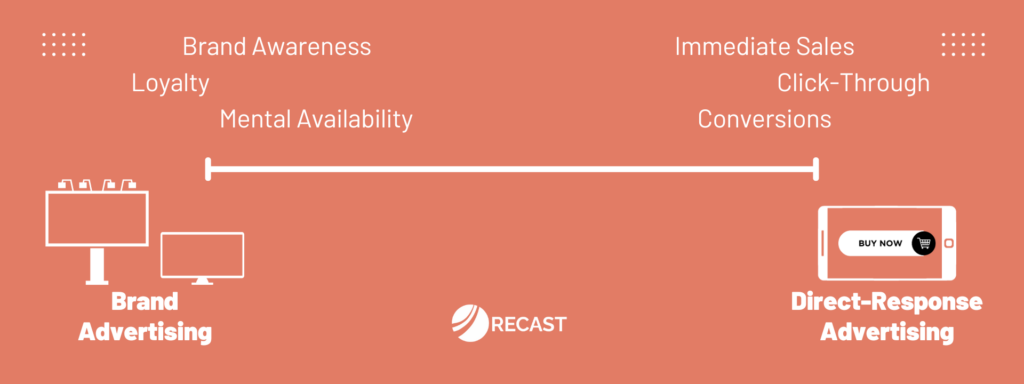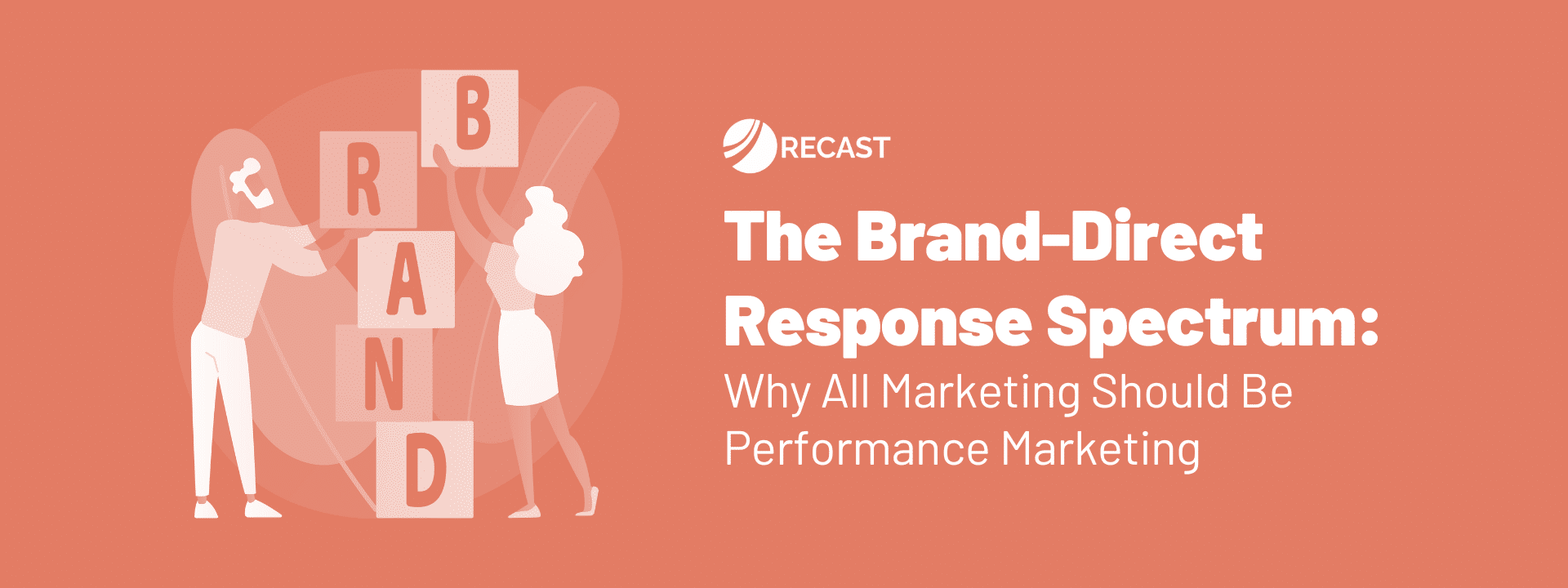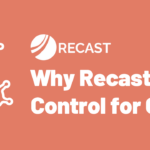Marketers often talk about the brand-performance spectrum, but we look at this differently at Recast. We believe that all marketing should be performance marketing – every dollar you’re putting out to the world and every marketing activity should have a goal and a way to measure its impact.
That doesn’t mean that every campaign is measured on the number of clicks or on a strict CPA to conversion cost payback window. But every marketing dollar needs to be measured – in its own appropriate way. Even if you’re running a “brand campaign,” marketing teams need to at least question how they will measure its impact – surveys for brand awareness lift, etc.
So, if all marketing is performance marketing, then we need to talk about the “brand-direct response spectrum.”
What is the “brand-direct response spectrum”?

The brand-direct response spectrum is a continuum that ranges from activities that are focused on building brand awareness and loyalty (brand) to activities that are focused on driving immediate sales (direct response).
On one side of the spectrum, we have brand advertising. This type of advertising is often run on traditional media channels like out-of-home and linear TV, radio, etc. The goal of brand advertising is not necessarily to drive an e-commerce conversion immediately after seeing the ad, but rather to build mental availability so that when a customer is in their consideration stage, they choose one brand over the other.
On the other side of the spectrum, we have direct-response advertising. This type of advertising is typically more focused on driving immediate sales. It is often seen on channels like social media and search engines. Direct response advertising often uses calls to action like “buy now” or “click here” to encourage customers to take action immediately.
Both brand and direct response advertising is performance marketing, so where you land on that spectrum for some particular marketing campaign will depend upon your strategy, how you are thinking about growing that brand, and what your business needs today.
If your business is a small, D2C startup, you’re probably going to be doing a lot more direct response advertising. This is because you need to quickly generate sales to build your business.
If you sell a lot more in grocery stores or big box retailers and you don’t really do a lot of e-commerce selling, then you’re probably going to be more on the brand side. This is because you need to build brand awareness and loyalty among customers who are not yet familiar with your brand.
No matter where you land on the brand-direct response spectrum, it is important to measure the effectiveness and impact of –all– your marketing dollars.
Direct response advertising can be more easily measured using a triangulation of methods, including marketing mix modeling (MMM), digital tracking, and experiments. There’s a playbook there.
Brand effects, on the other hand, are tricky because digital tracking cannot capture the full impact of brand advertising. These tend to be very substantial investments with a high risk of wasted spend, and with absolutely no plan for how to measure it. We will focus on this specifically in this article.
How to measure brand effects:
There are two types of brand effects, and they’re measured differently.
Short-term effects happen soon after that advertising goes out in the world. For example, running a radio ad and people listening to it in the car on the way to the grocery store, and that specifically driving them to prefer one product over a different one.
Short-term effects can be measured with a variety of experiments or with MMM. The goal is to make the connection between the ad spend and the lift of purchases over the baseline so we’re able to attribute those additional sales to that extra marketing activity.
The other type is long-term brand effects, and these are a lot more difficult to measure.
The idea behind them is that your ad spend has built up mental availability across a large swath of the population, and that means people are more likely to purchase from your brand six, twelve months, or even years from now.
The problem is – this is not really a good fit for measuring with experiments. Even with MMM, once you get out beyond three months, the effects tend to be very attenuated so they’re very difficult to estimate precisely and robustly with the model.
What I recommend is that brands advertising on this side of the brand-direct response spectrum use surveys on brand awareness to understand how they are driving that mental availability for customers without necessarily having to rely only on purchases to see how that’s changing.
Then, what we can do statistically is start to understand what the relationship is between brand awareness and downstream changes in marketing performance. For every extra 5 points of unaided awareness, all your marketing might become 5% more efficient, for example.
Finding the link between these factors will allow us to make better-informed decisions about how we want to allocate dollars across our marketing mix.
TLDR: The brand-direct response spectrum:
- All marketing should be performance marketing, and every marketing dollar should be measured in its own appropriate way.
- Direct response advertising can be more easily measured using a triangulation of methods, including marketing mix modeling (MMM), digital tracking, and experiments. Brand effects are more difficult to measure because digital tracking cannot capture the full impact of brand advertising.
- Short-term brand effects can be measured with experiments and marketing mix modeling (MMM).
- Long-term brand effects are more difficult to measure but can be important for long-term business success. Surveys can be used to measure brand awareness, which can help to understand the impact of brand advertising on downstream metrics such as customer lifetime value.



